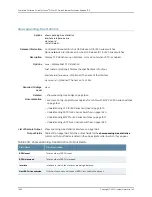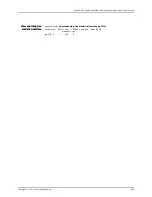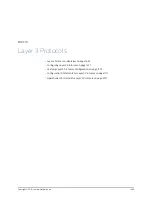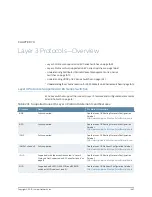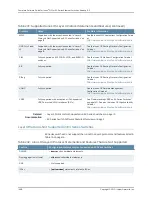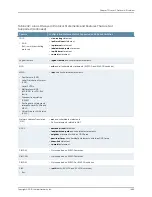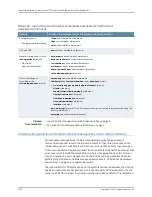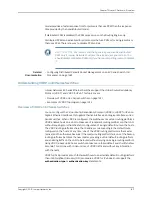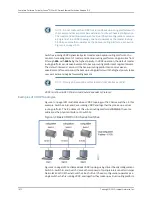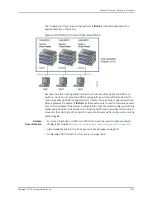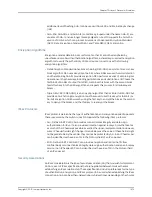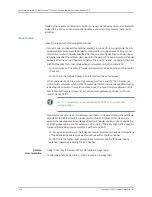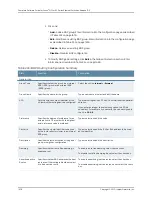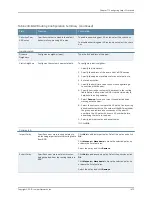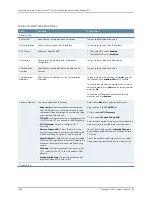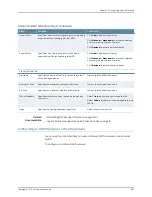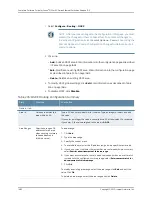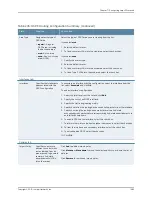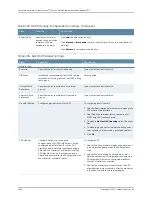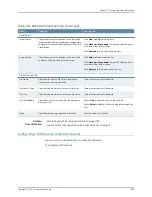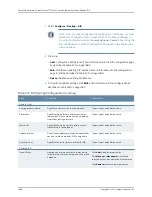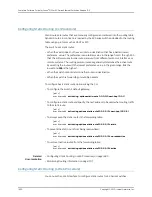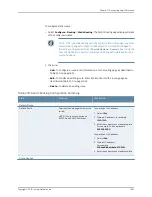
made by the network administrator. An SA is uniquely identified by a Security Parameter
Index (SPI), an IPv4 or IPv6 destination address, and a security protocol (AH or ESP)
identifier.
IPsec Modes
Junos OS supports the following IPsec modes:
•
Tunnel mode is supported for both AH and ESP in Junos OS. In tunnel mode, the SA
and associated protocols are applied to tunneled IPv4 or IPv6 packets. For a tunnel
mode SA, an outer IP header specifies the IPsec processing destination and an inner
IP header specifies the ultimate destination for the packet. The security protocol header
appears after the outer IP header and before the inner IP header. In addition, there are
slight differences for tunnel mode when you implement it with AH and ESP:
•
For AH, portions of the outer IP header are protected, as well as the entire tunneled
IP packet.
•
For ESP, only the tunneled packet is protected, not the outer header.
When one side of an SA is a security gateway (such as a switch), the SA must use
tunnel mode. However, when traffic (for example, SNMP commands or BGP sessions)
is destined for a switch, the system acts as a host. Transport mode is allowed in this
case because the system does not act as a security gateway and does not send or
receive transit traffic.
NOTE:
Tunnel mode is not supported for OSPF v3 control packet
authentication.
•
Transport mode provides an SA between two hosts. In transport mode, the protocols
provide protection primarily for upper-layer protocols. A transport mode security
protocol header appears immediately after the IP header and any options and before
any higher-layer protocols (for example, TCP or UDP). There are slight differences for
transport mode when you implement it with AH and ESP:
•
For AH, selected portions of the IP header are protected, as well as selected portions
of the extension headers and selected options within the IPv4 header.
•
For ESP, only the higher-layer protocols are protected, not the IP header or any
extension headers preceding the ESP header.
Related
Documentation
•
Using IP Security to Secure OSPFv3 Networks on page 1699
•
Configuring an OSPF Network (J-Web Procedure) on page 1681
Copyright © 2010, Juniper Networks, Inc.
1676
Complete Software Guide for Junos
®
OS for EX Series Ethernet Switches, Release 10.3
Summary of Contents for JUNOS OS 10.3 - SOFTWARE
Page 325: ...CHAPTER 17 Operational Mode Commands for System Setup 229 Copyright 2010 Juniper Networks Inc ...
Page 1323: ...CHAPTER 56 Operational Mode Commands for Interfaces 1227 Copyright 2010 Juniper Networks Inc ...
Page 2841: ...CHAPTER 86 Operational Commands for 802 1X 2745 Copyright 2010 Juniper Networks Inc ...
Page 3367: ...CHAPTER 113 Operational Mode Commands for CoS 3271 Copyright 2010 Juniper Networks Inc ...
Page 3435: ...CHAPTER 120 Operational Mode Commands for PoE 3339 Copyright 2010 Juniper Networks Inc ...
Page 3529: ...CHAPTER 126 Operational Mode Commands for MPLS 3433 Copyright 2010 Juniper Networks Inc ...

